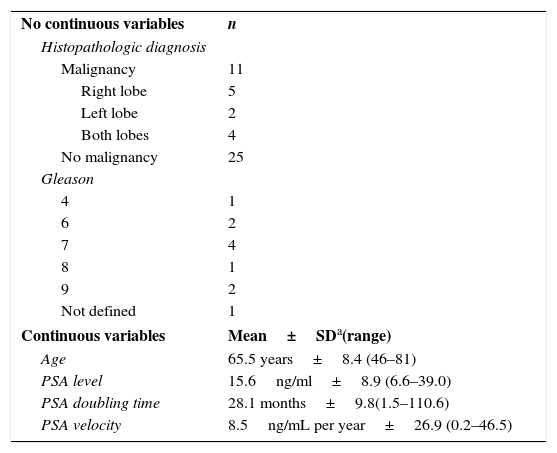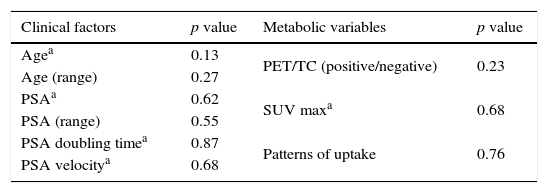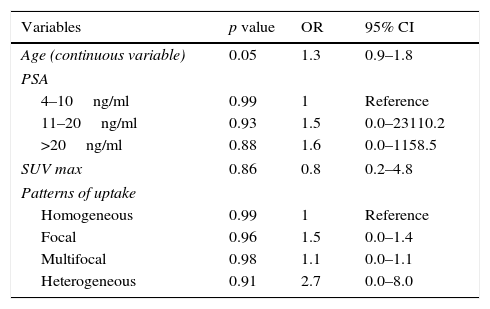To study 18F-Choline PET/CT in the diagnosis and biopsy guide of prostate cancer (pCa) in patients with persistently high prostate-specific antigen (PSA) and previous negative prostate biopsy. To compare the clinical risk factors and metabolic variables as predictors of malignancy.
MethodsPatients with persistently elevated PSA in serum (total PSA >4ng/mL) and at least a previous negative or inconclusive biopsy were consecutively referred for a whole body 18F-Choline PET/CT.
Patient age, PSA level, PSA doubling time (PSAdt) and PSA velocity (PSAvel) were obtained.
PET images were visually (positive or negative) and semiquantitatively (SUVmax) reviewed. 18F-Choline uptake prostate patterns were defined as focal, multifocal, homogeneous or heterogeneous. Histology on biopsy using transrectal ultrasound-guided approach was the gold standard.
Sensitivity (Se), specificity (Sp) and accuracy (Ac) of PET/CT for diagnosis of pCa were evaluated using per-patient and per-prostate lobe analysis. Receiver-operating-characteristic (ROC) curve analysis was used to assess the value of SUVmax to diagnose pCa.
Correlation between PET/CT and biopsy results per-prostate lobe was assessed using the Chi-square test. Univariate and multivariate logistic regression analysis were applied to compare clinical risk factors and metabolic variables as predictors of malignancy.
ResultsThirty-six out of 43 patients with histologic confirmation were included. In 11 (30.5%) patients, pCa was diagnosed (Gleason score from 4 to 9). The mean values of patient age, PSA level, PSAdt and PSAvel were: 65.5 years, 15.6ng/ml, 28.1 months and 8.5ng/mL per year, respectively.
Thirty-three patients had a positive PET/CT; 18 had a focal pattern, 7 multifocal, 4 homogeneous and 4 heterogeneous. Se, Sp and Ac of PET/CT were of 100%, 12% and 38% in the patient based analysis, and 87%, 29% and 14% in the prostate lobe based analysis, respectively. The ROC curve analysis of SUVmax showed an AUC of 0.568 (p=0.52).
On a lobe analysis, poor agreement was observed between PET/CT findings and biopsy results (p=0.097). In the univariate/multivariate analysis, none of clinical and metabolic variables were statistically significant as predictor of pCa.
ConclusionCholine PET/CT is a suitable procedure for the detection of pCa in highly selected patients, however, a high rate of false positive should be expected.
Estudiar el valor de la PET/TC con 18F-Colina en el diagnóstico y guía de biopsia para cáncer de próstata (pCa) en pacientes con PSA elevado y biopsias previas negativas. Comparar los factores de riesgo y las variables metabólicas como predictores de malignidad.
MétodosSe incluyeron pacientes derivados para PET/CT con 18F-colina, con PSA total sérico elevado (>4ng/mL) y al menos una biopsia negativa o no conclusiva para pCa. Se valoró la edad, el nivel de PSA, el tiempo de duplicación y la velocidad del PSA.
La PET fue valorada visual (positiva y negativa) y semicuantitativamente (SUVmáx). Se definieron los patrones de captación como focal, multifocal, homogéneo y heterogéneo. El diagnóstico final se obtuvo mediante histología obtenida por medio de biopsia guiada por ecografía transrectal.
Se valoró sensibilidad, especificidad y precisión diagnóstica utilizando un análisis por paciente y por lóbulos. Se utilizó una curva ROC para determinar el valor diagnóstico del SUVmáx.
Para valorar la correlación entre PET/TC y los resultados de la biopsia por lóbulos, se utilizó el test de Chi-Cuadrado. Realizamos un análisis univariado y multivariado mediante regresión logística para analizar los factores de riesgo y variables metabólicas como predictores de malignidad.
ResultadosSe incluyeron 36/43 pacientes con confirmación histológica. En 11 pacientes se diagnosticó pCa (Gleason de 4-9). El valor medio de edad, el nivel de PSA, el tiempo de duplicación y la velocidad de PSA fueron: 65,5 años, 15,6ng/ml, 28,1 meses y 8,5ng/mL por año, respectivamente. En 33 pacientes la PET/TC fue positiva: 18 presentaron patrón focal, 7 multifocal, 4 homogéneo y 4 heterogéneo. La sensibilidad, especificidad y precisión diagnóstica fue del 100%, 12% y 38% en el análisis por paciente, y 87%, 29% y 14% en el análisis por lóbulos, respectivamente. La curva ROC del SUVmáx mostró un AUC de 0,568 (p=0,52).
En el análisis por lóbulos se observó un escaso grado de acuerdo (p=0,097). Ninguna de las variables clínicas y metabólicas fue estadísticamente significativa como predictor de pCa en el análisis univariado/multivariado.
ConclusiónLa PET/TC con 18F-Colina es un procedimiento aceptable para la detección de cáncer de próstata en pacientes seleccionados. No obstante, puede presentar una alta tasa de falsos positivos.
Article
If you experience access problems, you can contact the SEMNIM Technical Secretariat by email at secretaria.tecnica@semnim.es or by phone at +34 619 594 780.

Revista Española de Medicina Nuclear e Imagen Molecular (English Edition)









